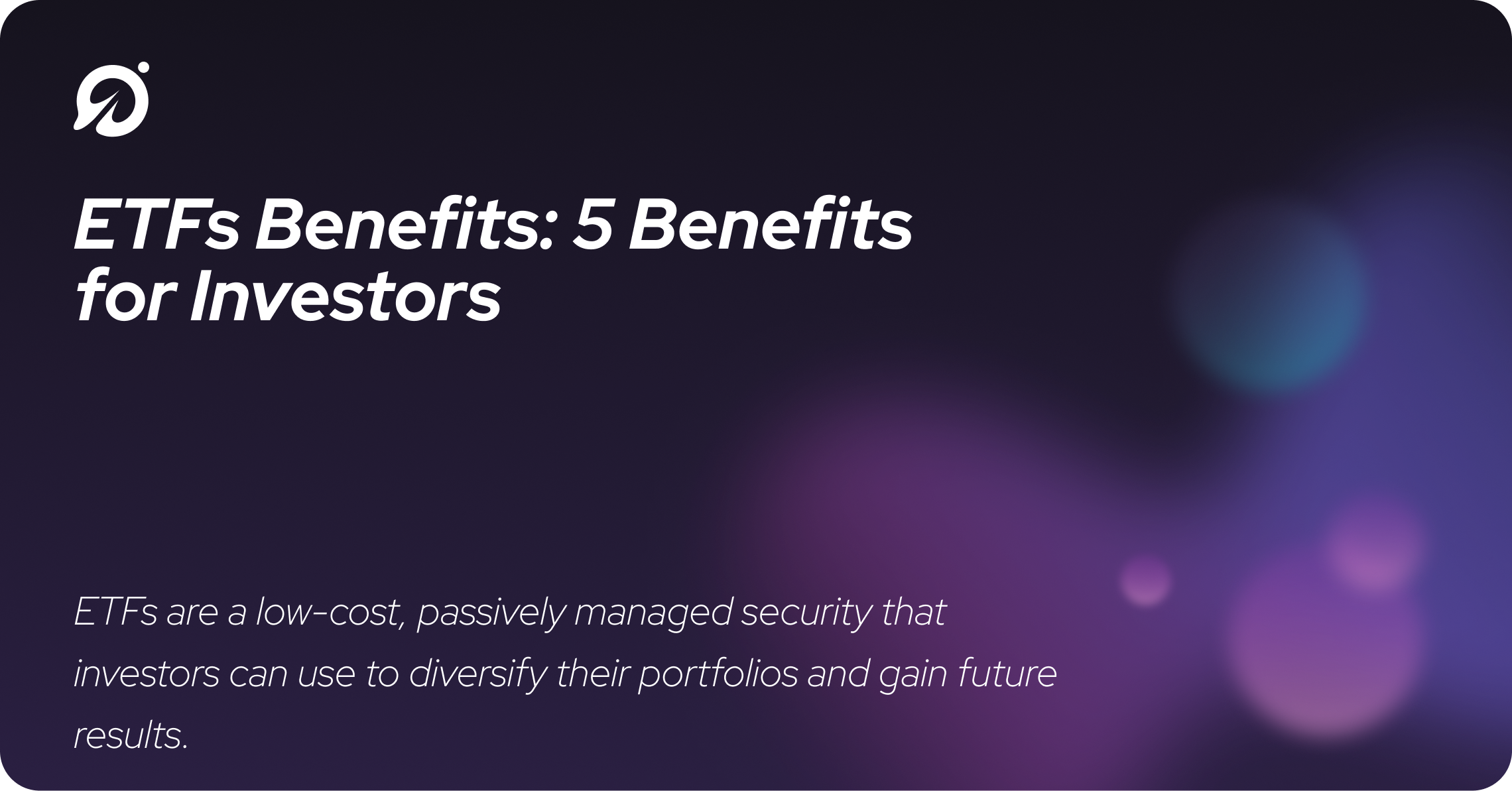ETFs Benefits: 5 Benefits for Investors
ETF, short for exchange-traded funds, is a versatile security traded on a broker exchange platform and operates similarly to mutual funds.

Disclaimer: This is for informational purposes and is not meant to serve as financial or investing advice.
An ETF tracks a particular index, sector, commodity, or other asset and can be purchased and sold on a stock exchange similarly to individual stocks. Read on as Pluto explores everything you should know.
How Do ETFs Work?
ETFs can be designed to track anything from the price of an individual commodity to a large basket of securities. ETFs can even be structured to follow specific investment strategies.
Most ETFs passively track a benchmark index, like the S&P 500, while others are monitored and actively managed.
Some of the main features of ETFs include:
- Pooled Security: Investors pool money into a professionally-managed portfolio, like mutual funds.
- Stock Exchange-traded: This means that, like stocks, ETFs are traded on a stock exchange platform and are open for purchase, at market price, during stock market hours of operation.
- Passively Managed: Many ETFs track the performance of an index, like the S&P 500.
- Low-cost: Because ETFs are designed to track a benchmark index, their overall operational costs are relatively low. These cost savings are passed along for the ETF investor’s benefit.
What Are Some Benefits of ETFs?
As there are many benefits to ETFs, here are 5 of the most prominent:
1. Diversification
One way that an investor can practice portfolio management is by diversification. This process ensures asset allocation of various investments, including index funds, stocks, ETF shares, and cryptocurrency.
Exchange-traded funds are a great investment vehicle to diversify a portfolio because ETFs have many asset classes, such as domestic equities, bonds, international equities, and real estate funds.
2. Immediate Access to Dividends
Growing in popularity amongst investors, dividend-paying exchange-traded funds provide high yields and more stability to a financial portfolio.
As with stocks and many mutual funds, most ETFs pay their dividends quarterly (once every three months) or once per month. This can be a lucrative form of passive cash flow.
3. Lower Cost
ETFs are known for their low-cost expense ratios compared to other securities. This is because ETFs passively follow an index rather than paying high wages to investment managers who scour the market for prospectus holdings.
4. Transparent
Although there is no direct law stating that ETFs need to disclose their holdings, by custom, ETFs provide full transparency of their portfolios to the public. This is a huge plus since the market is at an all-time low. Some well-known sites sharing ETF portfolio information include iShares and ETF.com.
5. Tax Efficient
ETFs can be tax efficient for a few reasons. One reason is low turnover, and two is that ETF shareholders are safeguarded from the actions of other investors.
The majority of ETFs are index funds, which are typically traded less frequently than actively managed funds.
Since ETFs are pegged for having low turnover, they pay out less of their net asset value (NAV) in capital gains to their holders. Low turnover means that there are fewer sales of stocks that have appreciated, resulting in less realized capital gains.
So, ETF owners are likely to incur capital gains taxes only if they sell their appreciated investments.
What Are the Risks of ETFs?
Ultimately, ETFs pose less risk than other types of securities, but there are some risks that are worth considering.
1. Liquidity
Some ETFs run the risk of being sold short. If a panic occurs and a specific fund is heavily shorted, the fund may not have enough cash to support the payouts. Hence, it is vital to choose ETFs that have high liquidity.
2. Lower Dividend Yield
There are lower dividend-paying ETFs, but the yields may be lower than those gained from a high-yielding stock. Since ETFs track a broader market, the overall yields will average lower than for a stock you can pick out by hand.
3. Intraday Pricing
Intraday pricing benefits active traders over long-term investors looking to buy and hold. This can pose a risk as the price may fluctuate throughout the day due to market volatility.
4. Possibility of Skewed Returns on Leveraged ETFs
A leveraged ETF is a fund that uses financial derivatives and debt to amplify the returns on an underlying asset. Leveraged ETFs can lose returns just as fast as you can gain them, which can skew overall returns. It is not wise to hold leveraged ETFs for more than one day, making them appealing to active traders over long-hold investors.
What Are Some Different Types of ETFs To Consider?
Crypto ETFs
Cryptocurrency is a type of digital currency that is designed to work as a medium of exchange.
Cryptocurrency ETFs allow investors to access the crypto market through their brokerage accounts. Due to its lack of government interference, a limited amount of crypto ETFs can be traded on U.S. markets.
Cryptocurrency ETFs sold on brokerage accounts now make it easier for individuals to gain exposure to cryptos, such as Bitcoin, as it is to purchase stocks.
Passive and Active ETFs
ETFs provide a convenient and low-cost way to invest in a bundle of asset classes while maintaining passive management.
A passive ETF tracks an index, like the S&P 500, and allows for portfolio updates regularly that will reflect changes found in the same benchmark index. This means that there is low maintenance required.
An active ETF consists of a fund manager who manages a portfolio of securities and makes investment decisions on behalf of the fund. Not all active ETF managers are transparent in their portfolio holdings which differ from passive ETFs.
Bond ETFs
Bond ETFs are exchange-traded funds that exclusively invest in bonds, fixed-income securities, and treasuries. They are similar to bond mutual funds as they hold a portfolio of bonds with different investment strategies.
Bond ETFs are passively managed and traded, like stock ETFs on significant stock exchanges. This aids in leveling out market stability and adding liquidity.
Stock ETFs
A stock exchange-traded fund tracks stocks and trades on major stock exchanges. They can provide exposure to a single industry or an entire equities index in one ETF trade.
These types of ETFs can provide holders with immediate diversification to their portfolios. Just like stocks, the market prices of ETFs can vary throughout the trading day.
Sector ETFs
Sector exchange-traded funds track an index that is made up of companies offering similar or related products or services within a specific sector of the economy. These sectors include energy, real estate, healthcare, and others.
Commodity ETFs
Commodity ETFs expose the price changes in raw materials, such as agricultural goods, natural resources, and metals. Commodity ETFs can either be physical or future-based.
Currency ETFs
Currency ETFs are pooled investments that provide exposure to foreign exchange currencies (forex). These ETFs track the changes in exchange rates in one or more currency pairs.
Currency ETFs can be purchased on major stock exchanges and are usually passively managed.
Leveraged ETFs
A leveraged exchange-traded fund is a security that uses financial derivatives and debt to amplify returns on an underlying asset.
Traditional ETFs usually track their underlying index on a 1:1 basis, while trading leveraged ETFs can track on a 2:1 or 3:1 basis. This means that returns can be much more significant, but so can the risk of losses.
You can find leveraged ETFs for most indexes.
The Bottom Line
As outlined, investing in ETFs has many benefits. ETFs provide diversification, passive management, transparency, and low costs. They can be easily purchased on major brokerage exchanges, making for a wise investment objective.
For more information on automated investing or where to get started, we can help. Start your investing journey today with Pluto.
Sources:
Exchange-Traded Fund (ETF) Explanation With Pros and Cons | Investopedia
How Do ETFs Work? Everything You Need to Know | ETF.com
Portfolio diversification by investing in ETFs | The Financial Express
8 ETFs that Pay Dividends Each Month | Investopedia
iShares Exchange Traded Funds (ETFs) | iShares | BlackRock
Find the Right ETF - Tools, Ratings, News | ETF.com
Why Are ETFs So Tax Efficient? | ETF.com
Advantages and Disadvantages of ETFs | Investopedia
7 Best Cryptocurrency ETFs to Buy | Investing | U.S. News
What Is a Bond ETF? Definition, Types, Examples, and How to Invest | Investopedia
